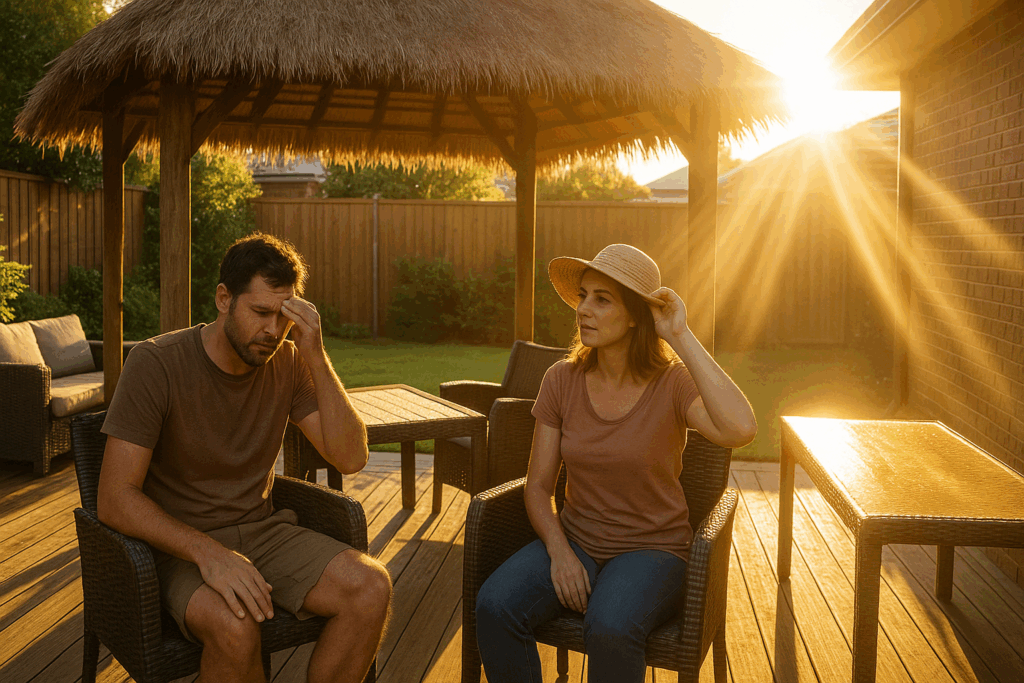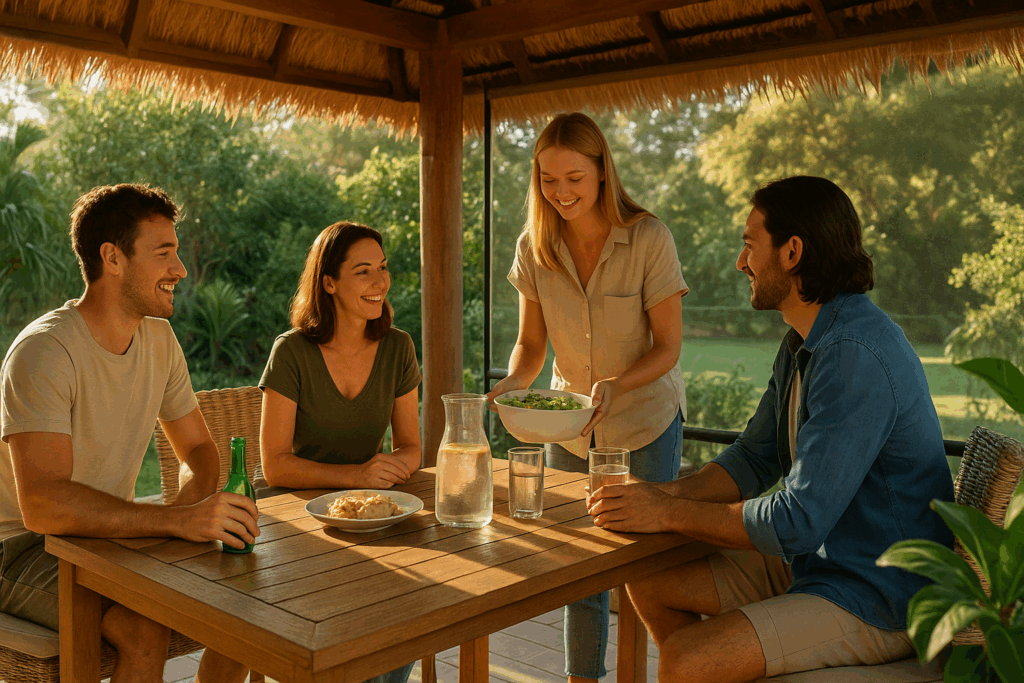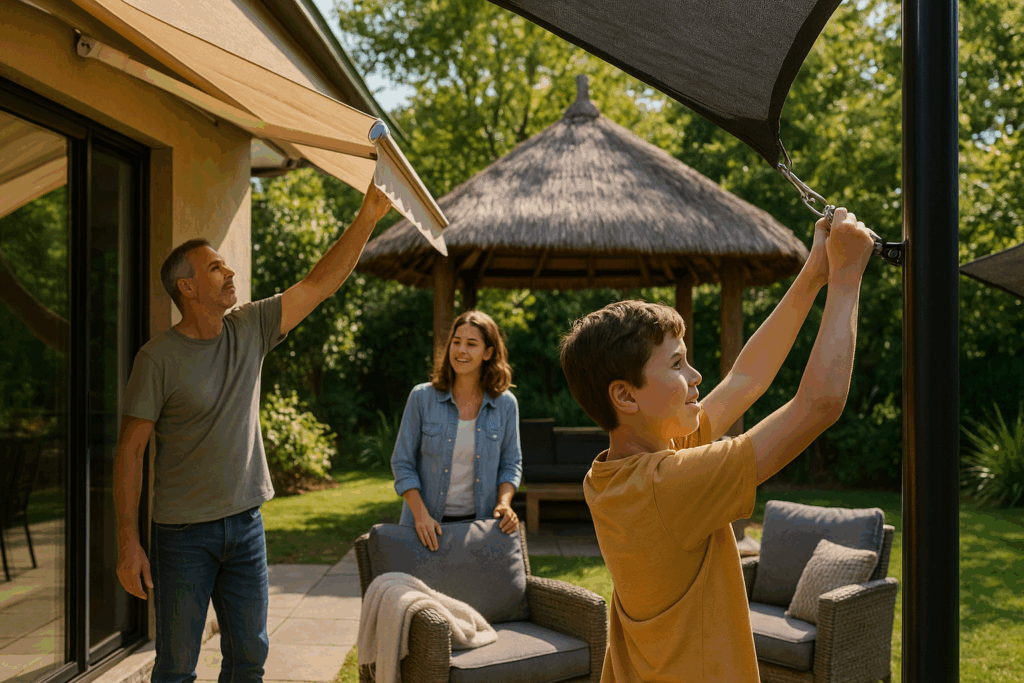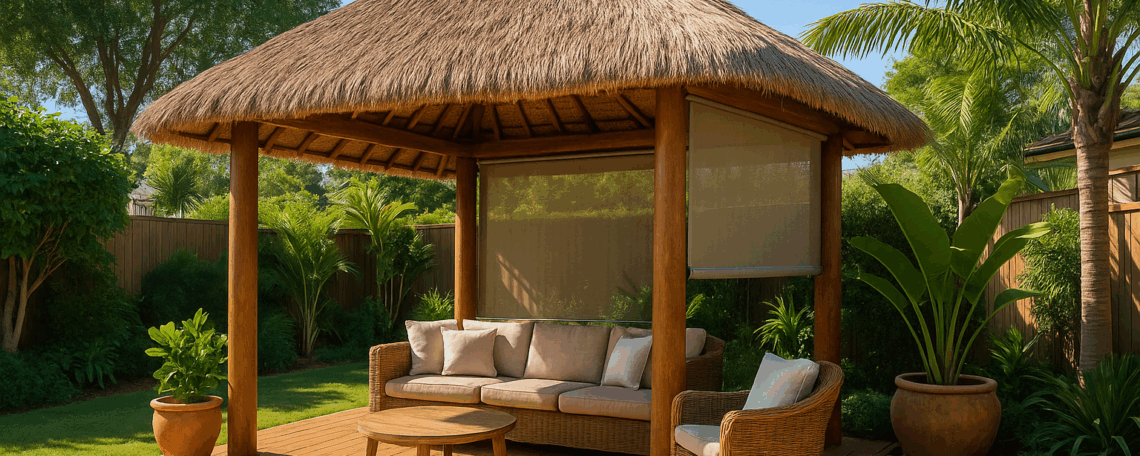If you’re finding your Bali hut isn’t as comfortable as you hoped during peak sun hours, you’re not alone.
The issue is that your beautiful thatch roof provides excellent overhead coverage, but the Australian sun comes from all angles. Those side rays and reflected heat can make your outdoor space uncomfortably warm when you want to relax the most.
In this guide, we’ll break down practical shade solutions so you’ll know exactly how to create all-day comfort in your backyard.
We’ll cover:
- Smart furniture positioning strategies
- Outdoor blinds for Australian conditions
- Natural cooling with plants
- Structural add-ons that deliver results
- Year-round maintenance tips
We’ve helped hundreds of homeowners in Australia solve this exact problem using these proven methods.
Read on to learn how to maximise your Bali hut comfort the right way.
Your Bali Hut Alone Won’t Beat the Harsh Aussie Sun
Why does your expensive Bali hut still feel like an oven during peak hours? The answer lies in basic design limitations that every structure faces.

Here’s what catches most homeowners off guard about standard coverage:
Why Roof-Only Shade Leaves You Vulnerable
Roof-only shade leaves you vulnerable because it can’t block the side angles where morning and afternoon sun sneak through. As the sun moves across the sky throughout the day, those rays slip in from the sides, gradually heating up your deck and outdoor furniture.
The Side-Sun Problem That Ruins Comfort
Reflected heat bounces off nearby surfaces like paving, deck boards, and house walls. This creates hot spots that your Bali hut’s thatch simply can’t block. This build-up of warmth is one of the biggest drawbacks of relying on roof-only shade.
When you understand these gaps, the next step is working with what you’ve already got.
Position Your Outdoor Furniture Like a Shade Expert
Thoughtful furniture placement doubles comfort without adding costs. The secret lies in understanding how heat moves through your backyard and positioning seating to avoid the hottest areas.
The best furniture strategies we’ve seen follow these principles:
- Strategic placement zones: Have you noticed how some spots stay hotter than others? That happens when benches and chairs sit too close to reflective surfaces such as paving or house walls. By shifting seating to the cooler side of your Bali hut, often the southern exposure, you create a more comfortable entertaining area.
- Heat-resistant materials that stay cool: Strong material choices set the tone for comfort. When furniture is built from treated timber or powder-coated metal, it stays noticeably cooler under the sun, unlike dark-coloured pieces that trap heat. To complete the setup, add light cushions or towels during the hottest months so the seating feels not only practical but also far more inviting.
- Creating multiple comfort zones: Our research shows that shaded seating can lower surface temperatures by several degrees. Instead of grouping all your outdoor furniture together, spread seating around your deck and garden. This setup lets everyone follow the shade throughout the day.
Outdoor Blinds That Block the Heat
Picture a summer afternoon under your Bali hut. The thatch roof blocks the overhead sun, but light still slips in from the sides. This is exactly when outdoor blinds become essential for keeping your space comfortable.

The most popular solution is PVC blinds, which work like sliding walls around your entertaining area. They drop down to block the harsh afternoon sun and roll back up to restore an open, airy feel. For those who prioritise airflow, café-style blinds are a smart choice because they block glare while allowing breezes to move through your seating area.
The foundation of success lies in investing in solid fittings from the start. For example, cheaper hardware may seem tempting, but it often fails during storms and leads to costly repairs. Beyond durability, quality blinds also protect your health, with the Cancer Council NSW confirming that well-designed shade structures can cut UV exposure by up to 75%.
To complete the picture, professional installation ensures the blinds blend naturally with the thatch roof and stand the test of time. After addressing the sun problem this way, the next step is adding plants for extra shade and natural cooling.
Green Solutions That Cool Your Great Outdoors Naturally
Plants work like natural air conditioners around your Bali hut, creating cooler microclimates in the backyard. The right native species enhances this effect by lowering temperatures by several degrees while adding beauty to the space.
The most effective plant choices for instant shade include:
Fast-Growing Trees That Handle Aussie Heat
Jacarandas and bottlebrush trees provide excellent coverage within a few years in most Australian gardens. These native plants flourish in our climate while creating substantial shade zones around your entertaining area. So, plant them on the western side of your huts where the afternoon sun hits hardest.
Where to Plant for Maximum Cooling Impact
The ideal placement for larger trees is about three metres away from your Bali hut’s roof, so strong winds or storms don’t cause damage. Then add layers of plants to your garden: tall trees for shade, medium shrubs for cover, and ground plants to fill in the gaps.
Together, these layers keep the air cooler around your seating area and reduce heat coming off paving or grass.
Add-On Structures That Complete Your Shade Setup
Your Bali hut provides great shade, but it can’t cover everything. Fortunately, add-on structures fill those gaps and work best when you plan them as part of your whole outdoor area.
In our experience, these additions give the best results:
- Retractable awnings for ultimate control: You can extend your Bali hut into a larger entertaining space by attaching a timber pergola to its frame. As a finishing touch, choose timber that reflects the thatch roof’s tone. After that, greenery overhead ensures comfort.
- Pergola extensions for seamless coverage: A timber pergola can attach to your hut’s frame and extend it into one large entertaining area. To keep the look consistent, choose a wood finish that matches the thatch roof. Then add climbing plants over the pergola to create shade and cool the deck.
- Shade sails for tricky sun angles: Quality shade sails can block sunlight where the hut can’t. For best results, install them between your house, fence posts, or garden structures to cover outdoor seating areas.
Your shade solutions need one final consideration to work all year round.
Make Your Shade Solutions Work All Year Round
Australian weather never stands still. Because of this, hot summers and cooler winters demand small adjustments to keep your outdoor space comfortable. If you make these adjustments, you not only stay comfortable but also protect your Bali hut and add-ons, ensuring they last for years.

Our team has found these maintenance steps work best:
Summer vs Winter Shade Requirements
In summer, your outdoor space needs as much protection as possible. That means extending awnings fully, closing blinds during the hottest hours, and moving furniture to the coolest spots around the hut.
When the season shifts to winter, the approach changes. Rather than blocking the sun, you’ll retract some shade to let the warming rays filter in. At the same time, small adjustments to pergola angles help balance the light with protection from chilly winds.
Care That Pays Off Long-Term
From our experience, regular upkeep prevents costly repairs. The reason is simple: small problems become expensive headaches when ignored, but catching them early saves hundreds of dollars down the track.
These simple maintenance steps prevent expensive problems:
- Clean thatch roofs yearly: Remove leaves and debris that block cooling airflow and can cause rot. This simple task prevents structural damage.
- After every storm, check shade sail attachments: Even small gaps in shade sail fittings can end up costing you a new sail. That’s due to the constant push and pull of wind stress, which weakens mounting points little by little.
- Monthly hosing keeps PVC blinds flexible: Regular hosing prevents cracking from sun damage that forces expensive replacements. Plus, clean blinds operate far more smoothly.
- Don’t overlook the motorised parts: An annual inspection catches electrical or mechanical issues while they’re still minor. Fixing them early costs far less than an emergency replacement when the system fails.
Maximise Your Outdoor Living Experience
Australian sun can make even the best Bali huts uncomfortably hot during peak hours, leaving your beautiful outdoor space underused. Fortunately, proven shade solutions exist that complement your existing thatch structure perfectly.
These solutions include strategic furniture placement, protective blinds, cooling native plants, and structural add-ons that work together to create lasting comfort. For long-term results, regular seasonal maintenance keeps everything effective so your backyard remains a welcoming place throughout the year.
Ready to maximise your Bali hut’s potential? Contact Georgia Wiseman today for expert advice on shade solutions that suit your space perfectly.
